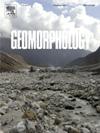沿石英砂岩台地悬崖的土壤动力学
IF 3.1
2区 地球科学
Q2 GEOGRAPHY, PHYSICAL
引用次数: 0
摘要
高原地貌的长期演化涉及多种机制和过程。外围悬崖的撤退被认为具有关键意义。在经历撤退的悬崖上,土壤是如何演变的,以及它们对撤退速度的影响,人们知之甚少。为了解决这一知识差距,设置了以下研究问题:(a)土壤的成分和性质如何随着距离砂岩盖层悬崖的距离而变化?(b)土料的风化情况如何?(c)悬崖峭壁内的侵蚀和沉积速率如何比较?波兰的Stołowe山脉提供了壮观的高原景观,砂岩盖层覆盖在泥岩和泥灰岩上,形成了形态上的两部分斜坡,顶部是悬崖线,下方是平面到凹形的斜坡。沿着Urwisko batorowski悬崖内的地形序列调查了八个剖面。利用放射性核素239+240Pu作为示踪剂,评估了该序列沿线的土壤侵蚀和沉积速率。为了全面了解与侵蚀过程相关的土壤特征,使用风化指数来表征风化严重程度。利用便携式光激发光阅读器进一步研究了土壤动力学。土壤表现出复杂的特征,从灰化土到石松土、gleysol,可能存在多源性土壤。土壤侵蚀和沉积速率沿坡面表现出高变异性,侵蚀速率为0.5-6.4 t ha - 1 yr - 1,沉积速率为0.2-6.9 t ha - 1 yr - 1,因此质量平衡几乎相等。风化指数和发光测量显示了这些土壤的高动态性。沿剖面和层序内的一些突变表明土壤的(岩性)不连续。因此,沿这种斜坡的土壤往往表现出多成因的特征。虽然该地区是森林,但土壤再分配率似乎与农业用地相当。土壤动力学表明,整个陡坡是一个活跃的形态动力学域,尽管缺乏这种活动的明确地貌记录。本文章由计算机程序翻译,如有差异,请以英文原文为准。
Soil dynamics along an escarpment of a quartz sandstone tableland
Long-term geomorphic evolution of tablelands involves various mechanisms and processes. The retreat of peripheral escarpments is assumed to be of key significance. How soils evolve on escarpments undergoing retreat and what they tell about the pace of this retreat is poorly understood. To address this knowledge gap, the following research questions were set: (a) How do the composition and the properties of soils change with distance from a sandstone caprock escarpment? (b) What is the weathering state of the soil material? (c) How do erosion and deposition rates compare within an escarpment cliff?
The Stołowe Mountains in Poland provide a spectacular tableland landscape where a sandstone caprock overlies mudstones and marls, resulting in morphologically bipartite slopes, with a cliff line at the top and planar to concave slopes below. Eight profiles along a toposequence within the escarpment of Urwisko Batorowskie were investigated. By using the fallout radionuclides 239+240Pu as a tracer, soil erosion and deposition rates along the sequence were assessed. For a comprehensive understanding of soil characteristics in relation to erosion processes, weathering severity was characterised by using weathering indices. Soil dynamics were further investigated using a portable optically stimulated luminescence reader. The soils exhibited complex characteristics and varied from Podzols to Stagnosols, Gleysols and possibly polygenetic soils. Soil erosion and deposition rates showed a high variability along the slope, with erosion rates of 0.5–6.4 t ha−1 yr−1 and deposition rates of 0.2–6.9 t ha−1 yr−1, and thus an almost equal mass balance. Weathering indices and luminescence measurements revealed the high dynamics of these soils. Some abrupt changes along the profiles and within the sequence indicated (lithological) discontinuities in the soils. Consequently, soils along such slopes often exhibit a polygenetic character. Although the area is forested, soil redistribution rates appeared comparable to agricultural land. The soil dynamics showed that the entire escarpment is an active morphodynamic domain, notwithstanding the paucity of clear landform record of this activity.
求助全文
通过发布文献求助,成功后即可免费获取论文全文。
去求助
来源期刊

Geomorphology
地学-地球科学综合
CiteScore
8.00
自引率
10.30%
发文量
309
审稿时长
3.4 months
期刊介绍:
Our journal''s scope includes geomorphic themes of: tectonics and regional structure; glacial processes and landforms; fluvial sequences, Quaternary environmental change and dating; fluvial processes and landforms; mass movement, slopes and periglacial processes; hillslopes and soil erosion; weathering, karst and soils; aeolian processes and landforms, coastal dunes and arid environments; coastal and marine processes, estuaries and lakes; modelling, theoretical and quantitative geomorphology; DEM, GIS and remote sensing methods and applications; hazards, applied and planetary geomorphology; and volcanics.
 求助内容:
求助内容: 应助结果提醒方式:
应助结果提醒方式:


